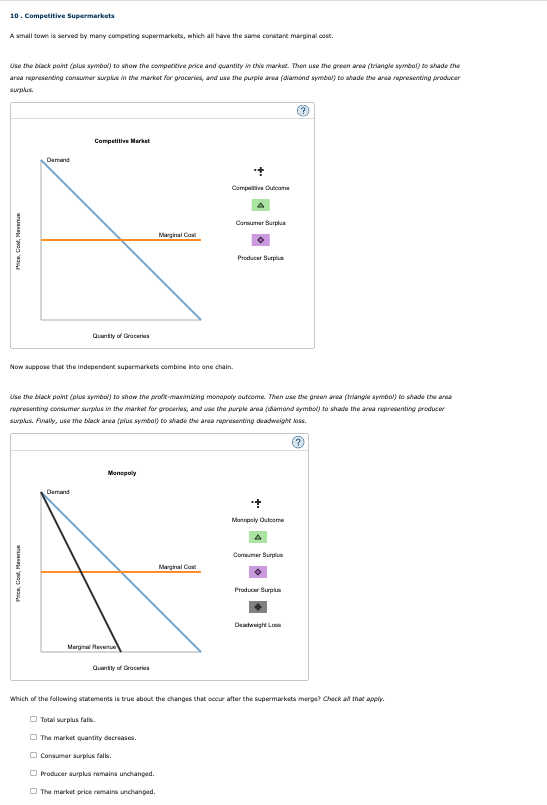10. Competitive Supermarkets A small town is served by many competing supermarkets, which all have the same constant marginal cost. Use the black point (plus symbol) to show the competitive price and quantity in this market. Then use the green area (triangle symbol) to shade the area representing consumer surplus in the market for groceries, and use the purple area (diamond symbol) to shade the area representing producer surplus. Price, Cost, Revenue Demand Competitive Market Quantity of Groceries Competitive Outcome Consumer Surplus Marginal Co Producer Surplus Now suppose that the independent supermarkets combine into one chain. Use the black point (plus symbol) to show the profit-maximizing monopoly outcome. Then use the green area (triangle symbol) to shade the area representing consumer surplus in the market for groceries, and use the purple area (diamond symbol) to shade the area representing producer surplus. Finally, use the black area (plus symbol) to shade the area representing deadweight loss. Price, Cost, Revenue Demand Monopoly Marginal Revenu Quantity of Groceries + Monopoly Outcome Consumer Surplus Marginal Co Producer Surplus Deadweight L (?) Which of the following statements is true about the changes that occur after the supermarkets merge? Check all that apply. Total surplus falls. The market quantity decreases. Consumer surplus falls. Producer surplus remains unchanged. The market price remains unchanged.
10. Competitive Supermarkets A small town is served by many competing supermarkets, which all have the same constant marginal cost. Use the black point (plus symbol) to show the competitive price and quantity in this market. Then use the green area (triangle symbol) to shade the area representing consumer surplus in the market for groceries, and use the purple area (diamond symbol) to shade the area representing producer surplus. Price, Cost, Revenue Demand Competitive Market Quantity of Groceries Competitive Outcome Consumer Surplus Marginal Co Producer Surplus Now suppose that the independent supermarkets combine into one chain. Use the black point (plus symbol) to show the profit-maximizing monopoly outcome. Then use the green area (triangle symbol) to shade the area representing consumer surplus in the market for groceries, and use the purple area (diamond symbol) to shade the area representing producer surplus. Finally, use the black area (plus symbol) to shade the area representing deadweight loss. Price, Cost, Revenue Demand Monopoly Marginal Revenu Quantity of Groceries + Monopoly Outcome Consumer Surplus Marginal Co Producer Surplus Deadweight L (?) Which of the following statements is true about the changes that occur after the supermarkets merge? Check all that apply. Total surplus falls. The market quantity decreases. Consumer surplus falls. Producer surplus remains unchanged. The market price remains unchanged.
Principles of Microeconomics
7th Edition
ISBN:9781305156050
Author:N. Gregory Mankiw
Publisher:N. Gregory Mankiw
Chapter14: Firms In Competitive Markets
Section: Chapter Questions
Problem 10PA
Related questions
Question

Transcribed Image Text:10. Competitive Supermarkets
A small town is served by many competing supermarkets, which all have the same constant marginal cost.
Use the black point (plus symbol) to show the competitive price and quantity in this market. Then use the green area (triangle symbol) to shade the
area representing consumer surplus in the market for groceries, and use the purple area (diamond symbol) to shade the area representing producer
surplus.
Price, Cost, Revenue
Demand
Competitive Market
Quantity of Groceries
Competitive Outcome
Consumer Surplus
Marginal Co
Producer Surplus
Now suppose that the independent supermarkets combine into one chain.
Use the black point (plus symbol) to show the profit-maximizing monopoly outcome. Then use the green area (triangle symbol) to shade the area
representing consumer surplus in the market for groceries, and use the purple area (diamond symbol) to shade the area representing producer
surplus. Finally, use the black area (plus symbol) to shade the area representing deadweight loss.
Price, Cost, Revenue
Demand
Monopoly
Marginal Revenu
Quantity of Groceries
+
Monopoly Outcome
Consumer Surplus
Marginal Co
Producer Surplus
Deadweight L
(?)
Which of the following statements is true about the changes that occur after the supermarkets merge? Check all that apply.
Total surplus falls.
The market quantity decreases.
Consumer surplus falls.
Producer surplus remains unchanged.
The market price remains unchanged.
Expert Solution
This question has been solved!
Explore an expertly crafted, step-by-step solution for a thorough understanding of key concepts.
This is a popular solution!
Trending now
This is a popular solution!
Step by step
Solved in 2 steps with 3 images

Recommended textbooks for you

Principles of Microeconomics
Economics
ISBN:
9781305156050
Author:
N. Gregory Mankiw
Publisher:
Cengage Learning

Principles of Economics (MindTap Course List)
Economics
ISBN:
9781305585126
Author:
N. Gregory Mankiw
Publisher:
Cengage Learning

Essentials of Economics (MindTap Course List)
Economics
ISBN:
9781337091992
Author:
N. Gregory Mankiw
Publisher:
Cengage Learning

Principles of Microeconomics
Economics
ISBN:
9781305156050
Author:
N. Gregory Mankiw
Publisher:
Cengage Learning

Principles of Economics (MindTap Course List)
Economics
ISBN:
9781305585126
Author:
N. Gregory Mankiw
Publisher:
Cengage Learning

Essentials of Economics (MindTap Course List)
Economics
ISBN:
9781337091992
Author:
N. Gregory Mankiw
Publisher:
Cengage Learning

Principles of Economics, 7th Edition (MindTap Cou…
Economics
ISBN:
9781285165875
Author:
N. Gregory Mankiw
Publisher:
Cengage Learning

Principles of Microeconomics (MindTap Course List)
Economics
ISBN:
9781305971493
Author:
N. Gregory Mankiw
Publisher:
Cengage Learning
